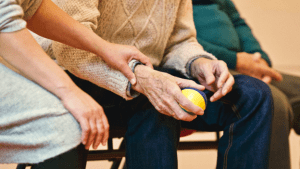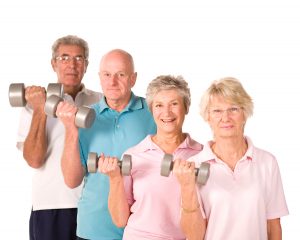Each week, Dr. Mauk shares thoughts relevant to Baby Boomers that are aimed to educate and amuse.
Guest Blog: Acupuncture: How It Works and the Various Benefits It Brings
 Acupuncture is a kind of traditional Chinese medicine that is based on the theory that a blockage or disruption in the flow of the body’s life force, or qi, can lead to health problems. Acupuncturists use small needles inserted into precise places on the body to balance energy, facilitate healing, and calm the body.
Acupuncture is a kind of traditional Chinese medicine that is based on the theory that a blockage or disruption in the flow of the body’s life force, or qi, can lead to health problems. Acupuncturists use small needles inserted into precise places on the body to balance energy, facilitate healing, and calm the body.
To say the least, acupuncture has a rich heritage. Documents detailing the practice date back to the first century BCE, but other archaeologists believe it dates back even further: maybe as far as 8,000 years ago.
It is a process where professional acupuncturists shallowly insert extremely thin needles into particular spots in the skin tissue in an attempt to unblock or alter divert the flow of energy. Acupoints are the names given to these points. Acupoints are counted in a variety of ways, although most systems count around 350-400 of them. Medical acupuncture is used for a variety of purposes, including pain reduction, and is now covered by many insurance policies.
To put things into perspective, let’s dive a little deeper.
How Acupuncture Works?
Endorphins are pain-relieving and pleasure-producing substances discovered by scientists in the 1970s. According to research, correctly conducted acupuncture can release endorphins, which can help with pain and nausea. It’s unclear how these small pegs trigger an endorphin surge.
It’s been tough to look into the practice. This is due to two key factors. The first is that various practitioners utilize different numbers of acupoints, prescribe varying amounts of sessions, and hold those sessions for varied lengths of time, which makes comparison difficult. The second problem for researchers is that people’s ideas and expectations, as well as how they feel about their therapist, may influence how effective the therapy seems to be in improving their diseases.
Benefits of Acupuncture
Most people are aware of acupuncture’s remarkable results on chronic pain relief and improved quality of life in people suffering from musculoskeletal ailments. This ancient therapeutic practice offers a slew of other physical, mental, and emotional advantages that few people are aware of. Acupuncture has a number of unexpected advantages, including the following:
Migraine and Headache:
Many people suffer from headaches on a regular basis. According to certain studies, stitching can give excellent, short-term relief for persistent tension headaches. Researchers have found that needle treatments for migraine headaches can be helpful even if they are not put in the right acupoints, and that they may have a larger impact than traditional medication therapy with fewer side effects.
Insomnia and Sleep Problems:
Acupuncture stimulates your body’s natural production of melatonin. This hormone governs your sleep-wake cycles when it is present in ideal proportions. It is typically underproduced today, owing to our contemporary lifestyle and bad sleeping habits, resulting in insomnia, frequent night awakenings, and constant exhaustion. If this continues for an extended period of time, it is a breeding environment for future health issues. Acupuncture can help you regain your natural ability to fall — and stay — asleep quickly.
Joint Pain:
Several studies and research suggested that acupuncture may be able to enhance the physical function of the knee in people with knee osteoarthritis in the short and long term. The connective tissue in the knee breaks down in this disorder. Acupuncture was also found to be effective in reducing knee discomfort in those with osteoarthritis of the knee, but only in the short term.
Energizes You:
Acupuncture can help you overcome lethargy or brain fog, whether you need a physical or mental energy boost to battle fatigue. An ideal set-point may be obtained and all organs can work properly by fully harmonizing the body’s energy environment. As a result, you may feel at peace, allowing you to get a better night’s sleep and become pain-free. Increased physical stamina and ability for clear and creative thinking result from stimulating the proper cerebral pathways.
Improves Digestion:
Acupuncture may cure practically all digestive issues by supporting the healthy functioning of the digestive system and its organs, as well as the rebalancing of possibly defective energy fields. While a lot of people walk towards dieting, we feel it is not sustainable. Acupuncture can assist with acute gastrointestinal disorders as well as severe symptoms of long-term persistent illnesses that have not been effectively treated, such as gallstones, Crohn’s Disease, or inflammatory bowel disease.
Enhances Fertility:
Acupuncture supports our reproductive systems and the appropriate synthesis of male and female hormones, making it a feasible option for couples struggling with infertility. Acupuncture may help a pregnancy develop smoothly, and it can even help the child’s position in the uterus be optimized for a natural and problem-free birth, protecting the mother’s fertility and physical reproductive health.
Maintains Blood Pressure:
In today’s world, rising blood pressure is an issue, especially with high-stress occupations and rising obesity rates. Regular acupuncture treatments, in combination with conventional therapy for the cardiovascular system, can help lower blood pressure. The technique supports appropriate cardiac function and blood flow, and it can be more successful in controlling blood pressure than medication.
Manages Menstrual Pain:
Acupuncture may help with dysmenorrhea, or painful periods, as well: Participants who got acupuncture reported as much relief from painful periods as those who took NSAIDs like ibuprofen or aspirin in a short research from 2013. In a 2008 research of 649 women, 15 acupuncture treatments spread out over three months were shown to be more effective than standard care in lowering menstruation discomfort and enhancing quality of life.
Final Takeaway
Acupuncture is widely accepted as a safe and effective treatment for a variety of ailments. Acupuncture sessions can last anywhere from 30 minutes to an hour, with the needles in for roughly 20 minutes. While the needles are implanted, some people may experience discomfort or pressure, while others may experience distinct feelings. Consult a professional acupuncturist if you’re not sure where to begin. An expert can show you where to apply pressure and how to do it correctly. For more information, you can reach out to us. We are always happy to help.




